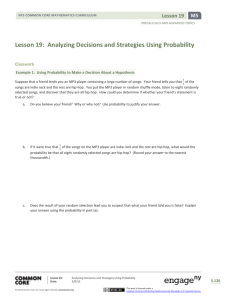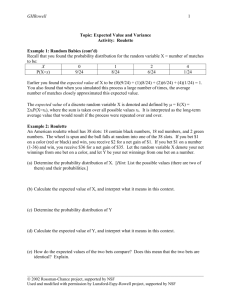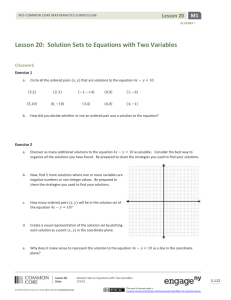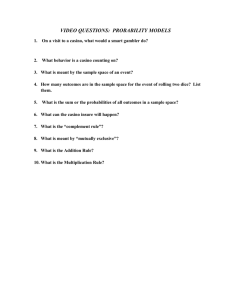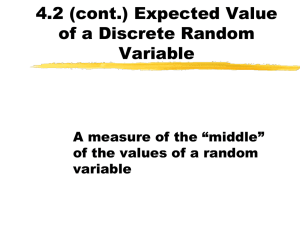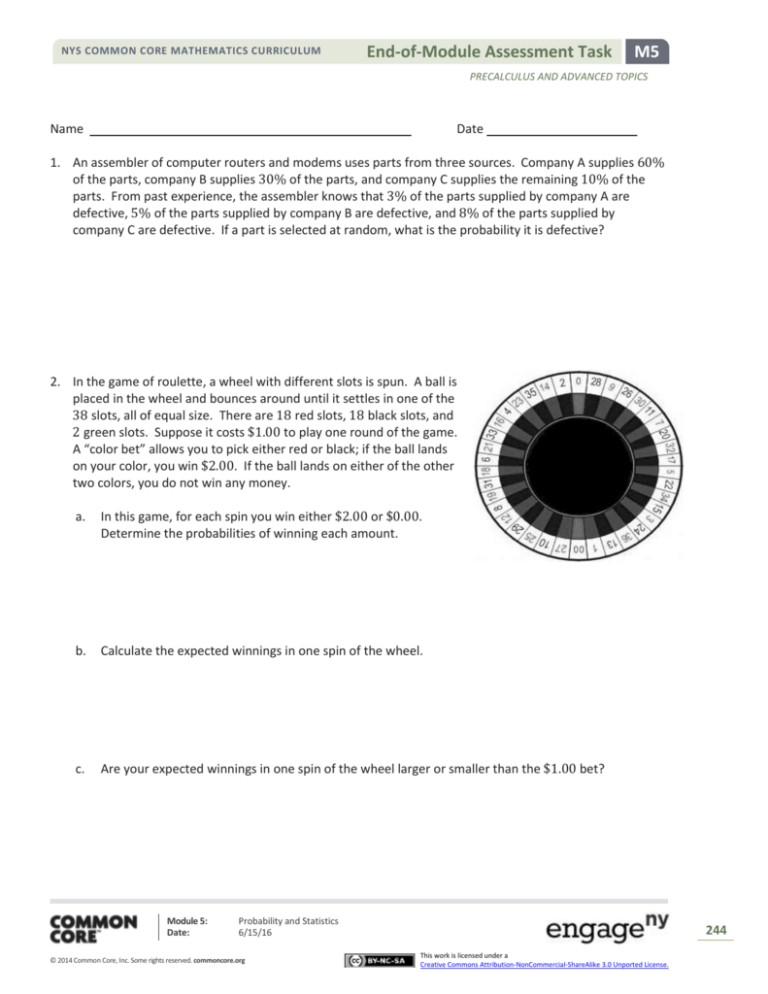
NYS COMMON CORE MATHEMATICS CURRICULUM
End-of-Module Assessment Task
M5
PRECALCULUS AND ADVANCED TOPICS
Name
Date
1. An assembler of computer routers and modems uses parts from three sources. Company A supplies 60%
of the parts, company B supplies 30% of the parts, and company C supplies the remaining 10% of the
parts. From past experience, the assembler knows that 3% of the parts supplied by company A are
defective, 5% of the parts supplied by company B are defective, and 8% of the parts supplied by
company C are defective. If a part is selected at random, what is the probability it is defective?
2. In the game of roulette, a wheel with different slots is spun. A ball is
placed in the wheel and bounces around until it settles in one of the
38 slots, all of equal size. There are 18 red slots, 18 black slots, and
2 green slots. Suppose it costs $1.00 to play one round of the game.
A “color bet” allows you to pick either red or black; if the ball lands
on your color, you win $2.00. If the ball lands on either of the other
two colors, you do not win any money.
a.
In this game, for each spin you win either $2.00 or $0.00.
Determine the probabilities of winning each amount.
b.
Calculate the expected winnings in one spin of the wheel.
c.
Are your expected winnings in one spin of the wheel larger or smaller than the $1.00 bet?
Module 5:
Date:
Probability and Statistics
6/15/16
© 2014 Common Core, Inc. Some rights reserved. commoncore.org
244
This work is licensed under a
Creative Commons Attribution-NonCommercial-ShareAlike 3.0 Unported License.
NYS COMMON CORE MATHEMATICS CURRICULUM
End-of-Module Assessment Task
M5
PRECALCULUS AND ADVANCED TOPICS
d.
A casino’s profit is equal to the amount of bets minus the amount of winnings. For each spin of the
Roulette wheel, the expected profit is $1.00 minus your expected winnings. What is the casino’s
expected profit? Explain why the game of roulette is still attractive to a professional casino even
though the expected profit to the casino is such a small amount on each spin.
e.
The slots are also numbered 0, 00, 1–36. If you bet on a number and win, you win $36.00. Which
bet is better for you: a number bet or a color bet? Explain your decision.
f.
Suppose you plan to construct a wheel with 12 slots: 5 red, 5 black, and 2 green. You plan to pay
$5.00 in winnings if someone picks a color (red or black) and the ball lands on that color. How much
should you charge someone to play (the bet amount) so that you have created a fair game?
3. In New York, the Mega Ball jackpot lottery asks you to pick 5 numbers (integers) from 1 to 59 (the “upper
section”) and then pick a Mega Ball number from 1 to 35 (the “lower section”). You win $10,000 if you
match exactly 4 of the 5 numbers from the upper section and match the Mega Ball number from the
lower section. The winning number(s) for each section are chosen at random without replacement.
Determine the probability of correctly choosing exactly 4 of the winning numbers and the Mega Ball
number.
Module 5:
Date:
Probability and Statistics
6/15/16
© 2014 Common Core, Inc. Some rights reserved. commoncore.org
245
This work is licensed under a
Creative Commons Attribution-NonCommercial-ShareAlike 3.0 Unported License.
NYS COMMON CORE MATHEMATICS CURRICULUM
End-of-Module Assessment Task
M5
PRECALCULUS AND ADVANCED TOPICS
4. A blood bank is screening a large population of donations for a particular virus. Suppose 5% of the blood
donations contain the virus. Suppose you randomly select 10 bags of donated blood to screen. You
decide to take a small amount from each of the bags and pool these all together into one sample. If that
sample shows signs of the virus, you then test all of the original 10 bags individually. If the combined
sample does not contain the virus, then you are done after just the one test.
a.
Determine the expected number of tests to screen 10 bags of donated blood using this strategy.
b.
Does this appear to be an effective strategy? Explain how you know.
5. Twenty-five sixth-grade students entered a math contest consisting of 20 questions. The student who
answered the greatest number of questions correctly will receive a graphing calculator. The rules of the
contest state that if two or more students tie for the greatest number of correct answers, one of these
students will be chosen to receive the calculator.
No student answered all 20 questions correctly, but four students (Allan, Beth, Carlos, and Denesha) each
answered 19 questions correctly.
What would be a fair way to use two coins (a dime and a nickel) to decide which student should get the
calculator? Explain what makes your method fair.
Module 5:
Date:
Probability and Statistics
6/15/16
© 2014 Common Core, Inc. Some rights reserved. commoncore.org
246
This work is licensed under a
Creative Commons Attribution-NonCommercial-ShareAlike 3.0 Unported License.
NYS COMMON CORE MATHEMATICS CURRICULUM
End-of-Module Assessment Task
M5
PRECALCULUS AND ADVANCED TOPICS
6. A cell phone company offers cell phone insurance for $7.00 a month. If your phone breaks and you
submit a claim, you must first pay a $200.00 deductible before the cell phone company pays anything.
Suppose the replacement cost for a phone is $650.00. This means if you break your phone and have
insurance, you have to pay only $200.00 toward the replacement cost. This plan has a limit of two
replacements; if you break your phone more than twice in one year, you pay for the full replacement cost
for the additional replacements.
Suppose that within one year, there is a 48% chance that you do not break your phone, a 36% chance
that you break it once, a 12% chance that you break it twice, a 3% chance that you break it three times,
and a 1% chance that you break it four times.
a.
Calculate the expected one-year cost of this insurance plan based on the monthly cost and the
expected repair costs.
b.
Determine your expected replacement costs if you do not purchase insurance.
c.
Does this insurance plan seem to be a good deal? Explain why or why not.
Module 5:
Date:
Probability and Statistics
6/15/16
© 2014 Common Core, Inc. Some rights reserved. commoncore.org
247
This work is licensed under a
Creative Commons Attribution-NonCommercial-ShareAlike 3.0 Unported License.
NYS COMMON CORE MATHEMATICS CURRICULUM
End-of-Module Assessment Task
M5
PRECALCULUS AND ADVANCED TOPICS
A Progression Toward Mastery
Assessment
Task Item
STEP 1
Missing or
incorrect answer
and little evidence
of reasoning or
application of
mathematics to
solve the problem.
STEP 2
Missing or
incorrect answer
but evidence of
some reasoning or
application of
mathematics to
solve the problem.
STEP 3
A correct answer
with some
evidence of
reasoning or
application of
mathematics to
solve the problem,
or an incorrect
answer with
substantial
evidence of solid
reasoning or
application of
mathematics to
solve the problem.
STEP 4
A correct answer
supported by
substantial
evidence of solid
reasoning or
application of
mathematics to
solve the problem.
1
S-CP.B.8
Student does not
recognize this as a
probability calculation
or combines the given
numbers in a
nonsensical way.
Student identifies
components of the
problem but is not able
to combine the
provided information in
an appropriate way.
AND/OR
Student shows how the
components are related
to the law of total
probability but ends up
with a probability
outside (0,1). Student
may also confuse the
law of total probability
with Bayes’s theorem.
Student identifies the
correct conditional and
unconditional
probabilities but makes
a calculation error, such
as weighting the
companies equally
(0.03 + 0.05 + 0.08)/
3.
Student identifies the
correct conditional and
unconditional
probabilities and
correctly performs the
probability calculation.
Student supports
answer with formulas
and/or diagrams.
2
a
Student assumes the
probabilities are both
0.50 because there are
only two outcomes
(win, lose).
Student finds the
probabilities for each
slot but does not
combine into the
outcomes of winning
and losing.
Student finds the
probabilities of winning
and losing but does not
relate to dollar
amounts.
Student finds the
probabilities for $2.00
and $0.00 based on the
roulette slots being
equally likely.
Student is not able to
determine an expected
value.
Student attempts to
find an expected value
but does not use the
probability distribution
from (a).
Student uses the
probability distribution
from (a) to calculate an
expected amount but
then rounds to $1.00.
Student uses the
probability distribution
from (a) to calculate an
expected amount.
S-MD.A.3
S-MD.B.5
b
S-MD.B.5
Module 5:
Date:
Probability and Statistics
6/15/16
© 2014 Common Core, Inc. Some rights reserved. commoncore.org
248
This work is licensed under a
Creative Commons Attribution-NonCommercial-ShareAlike 3.0 Unported License.
NYS COMMON CORE MATHEMATICS CURRICULUM
End-of-Module Assessment Task
M5
PRECALCULUS AND ADVANCED TOPICS
c
Student is not able to
compare the values.
Student does not use
the expected winnings
calculation.
Student makes a
comparison but not the
correct values. For
example, student tries
to utilize “net winnings”
instead.
Student compares the
answer in (b) to $1.00
and indicates which is
larger.
Student only focuses on
the casino using unfair
games.
Student brings in
outside information but
does not argue based
on expected profit for
large numbers of
customers.
Student understands
that the casino can be
confident they will win
$0.05 per spin, on
average, but does not
relate this to large
numbers of spins.
Student understands
that the answer to (c) is
not large but argues
based on the law of
large numbers.
Student does not
consider the probability
distribution and the
change in the amount
won.
Student compares the
bets but does not
calculate expected
winnings for the
numbered bets.
Student argues based
on expected values but
does not compare bets
or does not show
calculation details to
support answer.
Student calculates the
expected winnings for
the numbered bet and
makes a comparative
statement.
Student does not use
the given probability
distribution.
Student calculates the
probability of winning
but does not relate to
the amount bet.
Student calculates the
probability of winning
but assumes a $1.00
bet.
Student calculates the
expected winnings and
indicates that the cost
should be at least that
amount.
Student brings in
outside information
without using the
provided probability
distribution.
Student attempts to use
the multiplication rule
but is not able to
correctly calculate the
probability.
Student determines the
probability as one out
of the number of
possible combinations
but does not separate
the upper section and
lower section.
Student determines the
probability as one out
of the number of
possible combinations.
Student is not able to
calculate a probability
or an expected value
from the given
information.
Student only calculates
the probability of
needing a retest.
Student is not able to
convert to an expected
number of tests.
Student considers the
initial test and retest
but does not calculate
the probability of
needing a retest
correctly or does not
have the correct
outcomes for 𝑥 =
number of tests (e.g., 1
and 10).
Student calculates the
expected number of
tests considering the
initial test and the
retests.
Student does not
answer based on
expected number of
tests between the two
strategies.
Student considers the
expected number of
tests from (a) but does
not compare to 10.
Student finds the
strategy to be effective
but does not clearly
explain why.
Student compares the
expected number of
tests to 10.
S-MD.B.5
d
S-MD.A.2
e
S-MD.B.7
f
S-MD.B.6
3
S-CP.B.9
4
a
S-MD.B.7
b
S-MD.B.7
Module 5:
Date:
Probability and Statistics
6/15/16
© 2014 Common Core, Inc. Some rights reserved. commoncore.org
249
This work is licensed under a
Creative Commons Attribution-NonCommercial-ShareAlike 3.0 Unported License.
NYS COMMON CORE MATHEMATICS CURRICULUM
End-of-Module Assessment Task
M5
PRECALCULUS AND ADVANCED TOPICS
5
S-MD.B.6
6
a
S-MD.B.7
b
S-MD.B.7
c
S-MD.B.7
Student is not able to
describe a fair way to
decide who should be
awarded the calculator.
Student describes a
method that is not fair
or that does not use
two coins.
Student describes a fair
method using two
coins, but the
explanation does not
indicate that each
student is equally likely
to be awarded the
calculator.
Student describes a fair
method using two
coins, and the
explanation indicates
that each student is
equally likely to be
awarded the calculator.
Student does not
calculate an expected
cost.
Student considers the
costs but does not
combine them with the
probabilities.
Student makes a
calculation error (e.g.,
does not consider
deductible) or does not
show sufficient
calculation detail.
Student combines the
information to calculate
an expected repair cost.
Student is not able to
calculate an expected
cost.
Student states an
expected cost but not
based on the
probabilities of number
of phone breaks.
Student calculates an
expected cost but
makes a calculation
error (e.g., considers
information from the
plan) or does not show
sufficient calculation
detail.
Student calculates the
expected costs based
on probabilities of
breaking the phone 0–4
times.
Student brings in
outside information,
and the argument is not
based on previous
calculations.
Student answers based
on probability
distributions rather
than expected costs.
Student answers based
on expected costs but
does not clearly
compare the answers to
(a) and (b).
Student compares the
two expected values.
Module 5:
Date:
Probability and Statistics
6/15/16
© 2014 Common Core, Inc. Some rights reserved. commoncore.org
250
This work is licensed under a
Creative Commons Attribution-NonCommercial-ShareAlike 3.0 Unported License.
NYS COMMON CORE MATHEMATICS CURRICULUM
End-of-Module Assessment Task
M5
PRECALCULUS AND ADVANCED TOPICS
Name
Date
1. An assembler of computer routers and modems uses parts from three sources. Company A supplies 60%
of the parts, company B supplies 30% of the parts, and company C supplies the remaining 10% of the
parts. From past experience, the assembler knows that 3% of the parts supplied by company A are
defective, 5% of the parts supplied by company B are defective, and 8% of the parts supplied by
company C are defective. If a part is selected at random, what is the probability it is defective?
P(defective) = P(defective|A)P(A) + P(defective|B)P(B) + P(defective|C)P(C)
= 0.6(0.03) + 0.3(0.05) + 0.1(0.08) = 0.041.
2. In the game of roulette, a wheel with different slots is spun. A ball is
placed in the wheel and bounces around until it settles in one of the 38
slots, all of equal size. There are 18 red slots, 18 black slots, and 2 green
slots. Suppose it costs $1.00 to play one round of the game. A “color
bet” allows you to pick either red or black; if the ball lands on your color,
you win $2.00. If the ball lands on either of the other two colors, you do
not win any money.
a.
In this game, for each spin you win either $2.00 or $0.00.
Determine the probabilities of winning each amount.
P($2) =
P($0) =
b.
18
38
20
38
= 0.4737.
= 0.5263.
Calculate the expected winnings in one spin of the wheel.
expected winnings = 2(18/38) + 0(20/38) =
c.
36
38
= 0.9474.
Are your expected winnings in one spin of the wheel larger or smaller than the $1.00 bet?
This is smaller than the $1.00 bet (about 5 cents).
Module 5:
Date:
Probability and Statistics
6/15/16
© 2014 Common Core, Inc. Some rights reserved. commoncore.org
251
This work is licensed under a
Creative Commons Attribution-NonCommercial-ShareAlike 3.0 Unported License.
NYS COMMON CORE MATHEMATICS CURRICULUM
End-of-Module Assessment Task
M5
PRECALCULUS AND ADVANCED TOPICS
d.
A casino’s profit is equal to the amount of bets minus the amount of winnings. For each spin of the
Roulette wheel, the expected profit is $1.00 minus your expected winnings. What is the casino’s
expected profit? Explain why the game of roulette is still attractive to a professional casino even
though the expected profit to the casino is such a small amount on each spin.
The casino’s expected winnings are about 5 cents per spin. The law of large numbers
states that if they can get enough people to play, the average winnings will be very close
to the expected winnings. So, the casino will be pretty sure of being close to the
expected winnings. Even a small amount of expected winnings will add up over a large
number of spins.
e.
The slots are also numbered 0, 00, 1–36. If you bet on a number and win, you win $36.00. Which
bet is better for you: a number bet or a color bet? Explain how you are deciding.
expected winnings = 36(
1
)
38
=
36
.
38
The expected winnings are the same for the two bets. (So, you could argue that there
isn’t a difference, or you could argue in terms of the thrill vs. security of the bets.)
f.
Suppose you plan to construct a wheel with 12 slots: 5 red, 5 black, and 2 green. You plan to pay
$5.00 in winnings if someone picks a color (red or black) and the ball lands on that color. How much
should you charge someone to play (the bet amount) so that you have created a fair game?
expected winnings = 5(
5
)
12
=
25
.
12
So, you should charge approximately $2.08 to break
even. You should also accept $2.09 to cover the rounding from $2.083.
3. In New York, the Mega Ball jackpot lottery asks you to pick 5 numbers (integers) from 1 to 59 (the “upper
section”) and then pick a Mega Ball number from 1 to 35 (the “lower section”). You win $10,000 if you
match exactly 4 of the 5 numbers from the upper section and match the Mega Ball number from the
lower section. The winning number(s) for each section are chosen at random without replacement.
Determine the probability of correctly choosing exactly 4 of the winning numbers and the Mega Ball
number.
P(4 winning numbers and 1 Mega Ball) = (
1
C(56, 5)
) C(35, 1).
The probability of correctly choosing exactly 4 of the winning numbers and the Mega Ball
number is 0.00000000748 (7.48 x10-9)
Module 5:
Date:
Probability and Statistics
6/15/16
© 2014 Common Core, Inc. Some rights reserved. commoncore.org
252
This work is licensed under a
Creative Commons Attribution-NonCommercial-ShareAlike 3.0 Unported License.
NYS COMMON CORE MATHEMATICS CURRICULUM
M5
End-of-Module Assessment Task
PRECALCULUS AND ADVANCED TOPICS
4. A blood bank is screening a large population of donations for a particular virus. Suppose 5% of the blood
donations contain the virus. Suppose you randomly select 10 bags of donated blood to screen. You
decide to take a small amount from each of the bags and pool these all together into one sample. If that
sample shows signs of the virus, you then test all of the original 10 bags individually. If the combined
sample does not contain the virus, then you are done after just the one test.
a.
Determine the expected number of tests to screen 10 bags of donated blood using this strategy.
If none of the blood donations have the virus, then you only have to conduct one test.
The probability that none of the (independent) people have the virus is (1 – 0.05)10=
0.5987.
So, the expected number of tests is 1(0.5987) + 11(1 – 0.5987) = 5.01.
b.
Does this appear to be an effective strategy? Explain how you know.
This expected value in part (a) is much less than 10, so this seems to be an effective
strategy. In the long run, you will perform fewer tests.
5. Twenty-five sixth-grade students entered a math contest consisting of 20 questions. The student who
answered the greatest number of questions correctly will receive a graphing calculator. The rules of the
contest state that if two or more students tie for the greatest number of correct answers, one of these
students will be chosen to receive the calculator.
No student answered all 20 questions correctly, but four students (Allan, Beth, Carlos, and Denesha) each
answered 19 questions correctly.
What would be a fair way to use two coins (a dime and a nickel) to decide which student should get the
calculator? Explain what makes your method fair.
Answers will vary. One possible response is to toss the coins, and if both coins land heads up
(HH), Allan gets the calculator. If the dime lands heads up and the nickel lands tails up
(HT), Beth gets the calculator. If the dime lands tails up and the nickel lands heads up (TH),
Carlos gets the calculator. If both coins land tails up (TT), Denesha gets the calculator. This
1
method is fair because each of the four students has the same chance (a probability of ) of
4
getting the calculator.
Module 5:
Date:
Probability and Statistics
6/15/16
© 2014 Common Core, Inc. Some rights reserved. commoncore.org
253
This work is licensed under a
Creative Commons Attribution-NonCommercial-ShareAlike 3.0 Unported License.
NYS COMMON CORE MATHEMATICS CURRICULUM
End-of-Module Assessment Task
M5
PRECALCULUS AND ADVANCED TOPICS
6. A cell phone company offers cell phone insurance for $7.00 a month. If your phone breaks and you
submit a claim, you must first pay a $200.00 deductible before the cell phone company pays anything.
Suppose the replacement cost for a phone is $650.00. This means if you break your phone and have
insurance, you have to pay only $200.00 toward the replacement cost. This plan has a limit of two
replacements; if you break your phone more than twice in one year, you pay for the full replacement cost
for the additional replacements.
Suppose that within one year, there is a 48% chance that you do not break your phone, a 36% chance
that you break it once, a 12% chance that you break it twice, a 3% chance that you break it three times,
and a 1% chance that you break it four times.
a.
Calculate the expected one-year cost of this insurance plan based on the monthly cost and the
expected repair costs.
If you do not break your phone, then you pay $7 × 12 = $84.
If you break your phone once, then you pay $200 + $84 = $284.
If you break your phone twice, then you pay $400 + $84 = $484.
If you break your phone three times, then you pay $484 + $650 = $1134.
If you break your phone four times, then you pay $1134 + $650 = $1784.
The probability distribution of costs is as follows:
$84
$284
$484
$1134
$1784
0.48
0.36
0.12
0.03
0.01
Therefore, your expected costs are
0.48(84) + 0.36(284) + 0.12(484) + 0.03(1134) + 0.01(1784) = $252.50.
b.
Determine your expected replacement costs if you do not purchase insurance.
0.48(0) + 0.36(650) + 0.12(1300) + 0.03(1950) + 0.01(2600) = $474.50.
c.
Does this insurance plan seem to be a good deal? Explain why or why not.
Yes, the long-run average costs are considerably less with the insurance plan than
without it.
Module 5:
Date:
Probability and Statistics
6/15/16
© 2014 Common Core, Inc. Some rights reserved. commoncore.org
254
This work is licensed under a
Creative Commons Attribution-NonCommercial-ShareAlike 3.0 Unported License.

